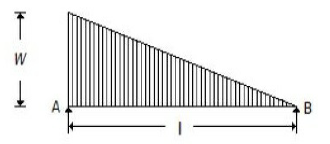The energy absorbed in a body, when it is strained within the elastic limits, is known as
Strain energy
Resilience
Proof resilience
Modulus of resilience
Correct Answer :
A. Strain energy
Related Questions
The ratio of elongation in a prismatic bar due to its own weight (W) as compared to another similar bar carrying an additional weight (W) will be
1 : 2
1 : 3
1 : 4
1 : 2.5
The heat flows from a cold body to a hot body with the aid of an external source. This statement is given by
Kelvin
Joule
Clausis
Gay-Lussac
The value of Poisson's ratio for steel is between
0.01 to 0.1
0.23 to 0.27
0.25 to 0.33
0.4 to 0.6
A process of heating crude oil to a high temperature under a very high pressure to increase the yield of lighter distillates, is known as
Cracking
Carbonisation
Fractional distillation
Full distillation
The standard value of atmospheric pressure taken at sea level is
1.013 bar
760 mm of Hg
1013 × 102 N/m2
All of these
The entropy may be expressed as a function of
Pressure and temperature
Temperature and volume
Heat and work
All of these
One kg of carbon monoxide requires __________ kg of oxygen to produce 11/7 kg of carbon dioxide gas.
4/7
11/4
9/7
All of these
In closed cycle gas turbine, the air is compressed
Isothermally
Isentropically
Polytropically
None of these
A bar of copper and steel form a composite system, which is heated to a temperature of 40°C. The stress induced in the copper bar will be
Tensile
Compressive
Shear
Zero
Which of the following statement is incorrect?
The liquid fuels consist of hydrocarbons.
The liquid fuels have higher calorific value than solid fuels.
The solid fuels have higher calorific value than liquid fuels.
A good fuel should have low ignition point.
According to kinetic theory of gases, the velocity of molecules __________ with the increase in temperature.
Remains constant
Increases
Decreases
None of these
When a bar is cooled to - 5°C, it will develop
No stress
Shear stress
Tensile stress
Compressive stress
Which of the following is a reversible non-flow process?
Isochoric process
Isobaric process
Hyperbolic process
All of these
A close cycle gas turbine gives __________ efficiency as compared to an open cycle gas turbine.
Same
Lower
Higher
None of these
Those substances which have so far not been resolved by any means into other substances of simpler form are called
Elements
Compounds
Atoms
Molecules
In order to prevent crushing of masonry at the base of the dam, the maximum stress should be __________ the permissible stress of the soil.
Equal to
Less than
More than
None of these
For the beam shown in the below figure, the shear force diagram between A and B is

A horizontal line
A vertical line
An inclined line
A parabolic curve
Two shafts 'A' and 'B' transmit the same power. The speed of shaft 'A' is 250 r.p.m. and that of shaft 'B' is 300 r.p.m.
The shaft 'B' has the greater diameter
The shaft 'A' has the greater diameter
Both are of same diameter
None of these
A cycle consisting of __________ and two isothermal processes is known as Stirling cycle.
Two constant pressure
Two constant volume
Two isentropic
One constant pressure, one constant volume
One Joule (J) is equal to
1 N-m
1 kN-m
10 N-m/s
10 kN-m/s
The reading of the pressure gauge fitted on a vessel is 25 bar. The atmospheric pressure is 1.03 bar and the value of 'g' is 9.81 m/s2. The absolute pressure in the vessel is
23.97 bar
25 bar
26.03 bar
34.81 bar
The compression ratio for Diesel engines is
3 to 6
5 to 8
15 to 20
20 to 30
According to First law of thermodynamics,
Total internal energy of a system during a process remains constant
Total energy of a system remains constant
Workdone by a system is equal to the heat transferred by the system
Internal energy, enthalpy and entropy during a process remain constant
The efficiency of Carnot cycle depends upon
Temperature limits
Pressure ratio
Volume compression ratio
Cut-off ratio and compression ratio
If in the equation pvn = C, the value of n = ∝, then the process is called
Constant volume process
Adiabatic process
Constant pressure process
Isothermal process
One kg of carbon monoxide requires 4/7 kg of oxygen and produces
11/3 kg of carbon dioxide gas
7/3 kg of carbon monoxide gas
11/7 kg of carbon dioxide gas
8/3 kg of carbon monoxide gas
The efficiency and work ratio of a simple gas turbine cycle are
Low
Very low
High
Very high
The amount of heat required to raise the temperature of __________ water through one degree is called kilojoules.
1 g
10 g
100 g
1000 g
The behaviour of a perfect gas, undergoing any change in the variables which control physical properties, is governed by
Boyle's law
Charles' law
Gay-Lussac law
All of these
The heat absorbed or rejected by the working substance is given by (where ds = Increase or decrease of entropy, T = Absolute temperature, and dQ = Heat absorbed or rejected)
δQ = T.ds
δQ = T/ds
dQ = ds/T
None of these
